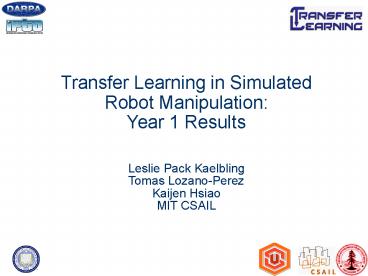Transfer Learning in Simulated Robot Manipulation: Year 1 Results - PowerPoint PPT Presentation
1 / 32
Title:
Transfer Learning in Simulated Robot Manipulation: Year 1 Results
Description:
Transfer ratio of 10 on levels 1 - 3. Transfer measured on percent of objects grasped successfully and correctly ... Transfer Level 1 ... – PowerPoint PPT presentation
Number of Views:50
Avg rating:3.0/5.0
Title: Transfer Learning in Simulated Robot Manipulation: Year 1 Results
1
Transfer Learning in Simulated Robot
Manipulation Year 1 Results Leslie Pack
Kaelbling Tomas Lozano-Perez Kaijen Hsiao MIT
CSAIL
2
Problem Statement
- We wish to enable a simulated robot to learn
whole-body grasps by imitation - A human demonstrates picking up 5 simulated
objects - The robot practices those grasp types on simple
objects - The robot performs the same grasp types on new
objects that are different than the training
objects, thus exhibiting transfer
3
Domain Performance Metrics
Updated time and slip information average time
82.8418604651 sec per grasp level 4 noA 932
good grasps out of 1000, (0.932000), avg slip
1.804184 cm level 4 transfer set 1 933 good
grasps out of 1000, (0.933000), avg slip
1.783139 cm level 4 transfer set 2 929 good
grasps out of 1000, (0.929000), avg slip
1.787407 cm
- Proposal stipulated domain performance metrics
- 300 sec/object part
- Our most complex objects have 3 parts
- ltPut actual timing results heregt
- 2cm mean squared error
- There was a typo in the proposal should have
been root mean squared error (which has the right
units) - The TL4 system successfully grasped objects ltXgt
percent of the time on the successfully grasped
objects, the RMS error was ltYgt. - Transfer ratio of 10 on levels 1 - 3
- Transfer measured on percent of objects grasped
successfully and correctly
4
Transfer Level 1
Method for choosingamong candidate grasps
- Task A Grasping one particular complex object in
a single position and orientation - Task B Grasping the same object in the same
orientation, but different positions - Transferred knowledge
- Examples for nearest-neighbor grasp type
selection - Quality metric for grasps
5
TL1 Raw Curves
6
TL1 Average Curves
7
TL1 Statistics
8
TL1 Transfer Ratio Curve
9
TL1 Notes
10
Transfer Level 2
Methods for choosingamong candidate grasps
- Task A Grasping one particular complex object
- Task B Grasping that same object in
arbitrary positions and orientations - Transferred knowledge
- Instances for nearest neighbor grasp type
selection - Quality metric for grasps
11
TL2 Raw Curves
Discrete performance levels due to test sets of
size 5
12
TL2 Average Curves
13
TL2 Statistics
14
TL2 Transfer Ratio Curve
15
TL2 Notes
16
Transfer Level 3
Methods for choosingamong candidate grasps
- Task A Grasping one particular complex object
- Task B Grasping other complex objects in
arbitrary positions and orientations - Transferred knowledge
- Instances for nearest neighbor grasp type
selection - Quality metric for grasps
17
TL3 Raw Curves
18
TL3 Average Curves
19
TL3 Statistics
20
TL3 Transfer Ratio Curve
21
TL3 Notes
22
Transfer Level 4
Methods for choosingamong candidate grasps
- Task A Grasping boxes
- Task B Grasping more complex objects in
arbitrary positions and orientations - Transferred knowledge
- Instances for nearest neighbor grasp type
selection - Quality metric for grasps
23
TL4 Raw Curves
24
TL4 Average Curves
25
TL4 Statistics
26
TL4 Transfer Ratio Curve
27
TL4 Notes
28
Experimental protocol summary
29
Experimental protocol
- details on (1) how the data was
obtained/constructed, (2) the time required by
each step of the protocol, (3) the cpu power and
setup used (e.g., 14 cpus running in parallel),
(4) any additional (e.g., grasping) hardware that
was used, etc.? It's unclear to me whether these
details are best described in a "domain-specific
evaluation protocol" slide or whether you'll
already cover this in the other slides you plan
to provide.
30
Experimental results summary
- If you can figure out a way to report all of your
results on one slide, that would be good.
31
Some Successful Grasps
32
A Few Failed Grasps
Most failures due to problems with controllers































